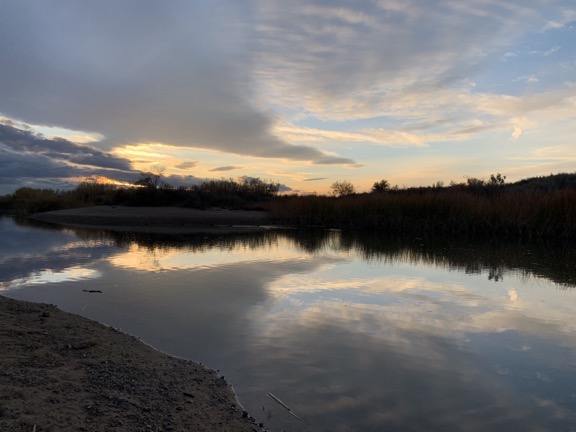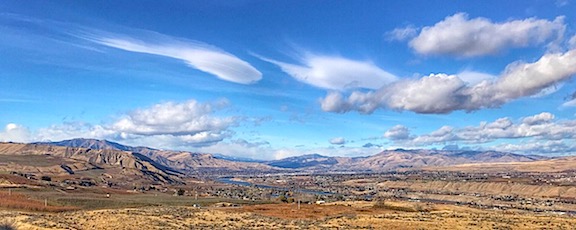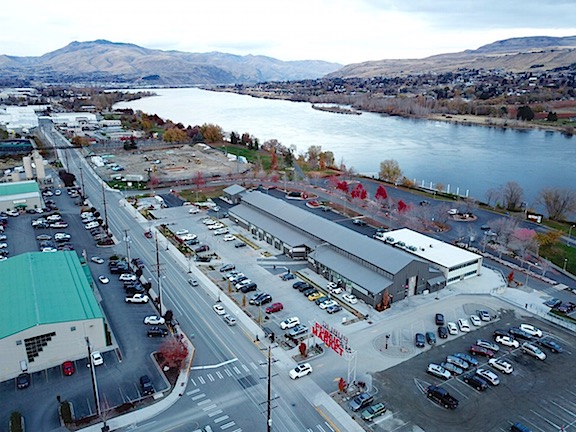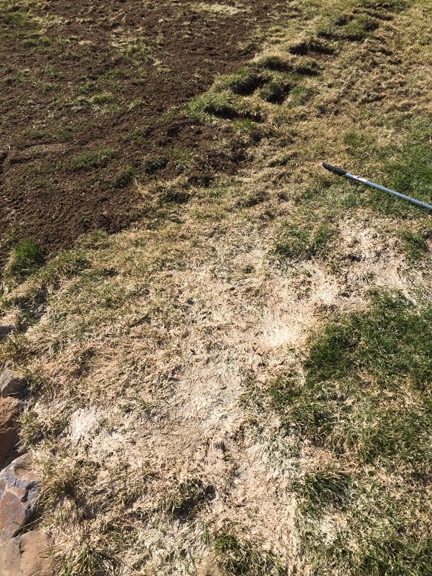It only took eleven years.
I’m halfway through my first full week in Arizona, the place so many mostly retired Americans go in the winter to escape the cold at their northern latitude homes. With my second winter season in a warmer climate now under way, I think it’s safe to say that I’m officially a snowbird.
I also realized that I’ve been doing some form of snowbirding for the past eleven years now, although I didn’t do it the usual way.
And I think I prefer it the way I do it now.
He’s the scoop. Be advised: this blog post includes the airing of some dirty laundry, which, unfortunately, is an integral part of the story and explains what took me so long to get here.
The Reverse Snowbird
For the eight or so years leading up to my eventual divorce and move to Washington state, I was a sort of reverse snowbird. Instead of migrating south for the winter, I migrated north for the summer.
2004 was the first year I did this. That’s when I got a job as a seasonal tour pilot at the Grand Canyon. A week in the significantly cooler Grand Canyon area followed by a week at home in Wickenburg. It was a busy summer. I was just another tour pilot at the Canyon, flying over “the big ditch” up to 13 times a day, but in my home office, I cranked out the fifth (or sixth?) edition of my best-selling Quicken Official Guide and got started on an Excel book. When I wasn’t home, I dealt with the relative discomfort of life in a horse trailer’s cramped living quarters, parked on 40 acres of property I owned with my future wasband five miles from pavement. I’d leave at 6 AM to get to work by 6:45. And yes, sometimes I did fly to work; I had a R22 parked beside my Jeep at the trailer. That’s the summer I decided to “go for broke” on my struggling helicopter charter business and order an R44.

Our Howard Mesa cabin was a nice place to escape from the heat.
In 2005, I had a brand new R44 helicopter but virtually no summer flying work. (Seriously: who wants to fly when it’s 110°F out?) When the Quicken book revision was done at the end of June, I headed back to the northern Arizona property with my horse trailer and horses. In a compromise with my future wasband, we’d had a prefabricated custom wooden shed delivered to the property. While he worked at one of the many jobs he bounced between in the Phoenix area, I spent all of July at the “cabin,” fitting its walls with hard foam insulation and building an interior wall to divide the main room from the future bathroom. On weekends, my future wasband would join me, handling tasks I couldn’t do then (but can certainly do now): wiring, plumbing, cutting lumber, fitting large sheets of T111 (think plywood paneling) on walls and ceilings. Together, we turned that shed into a very cozy four-season escape in a place where the Grand Canyon was our local park. But when the work was done, it was still too hot to hang out at home. So I hopped into my 2003 Honda S2000 (which I still own), and headed out on a 19-day road trip by myself to explore points north. I visited places (and friends) in Arizona, Nevada, California, Oregon, Washington, Idaho, Montana, Wyoming, and Utah, getting a real feel for a lot of the off-the-beaten-path places. I came back with a lead on a hangar home in Cascade, ID — perfect for a summer home — and even flew my future wasband up there with me to see it after I got home. (What a waste of time and money that was.)
In 2006, I made the mistake of marrying the man who would, six years later, leave me for a desperate old whore he met online. (Yes, I do realize now that the marriage was his attempt to “lock in” on the considerable financial, real estate, and business asset investments I’d been making since I had my first best-seller in 1998. But back then, I couldn’t imagine anyone I loved plotting to use family law to try to screw me over. Silly me.) I had some surgery in May and then went on a road trip with my wasband in that Honda to Napa Valley. That trip, which was the closest I’d get to a honeymoon, was probably the last fun trip we took together. Then it was back home to Wickenburg for the summer, with occasional trips to the cabin. That was also the first summer I heard about cherry drying, but my contact couldn’t guarantee me any work and I wasn’t willing to take the helicopter to Washington without some sort of guarantee of revenue.
In 2007, I worked on books, including that Quicken book again. Cherry drying was an option but again, without a guarantee of work, I wasn’t prepared to go north. But I was prepping for a seasonal lifestyle. Financially and mentally, I was ready for it. My wasband promised to join me on the road during the summer when he turned 55. In 2007, he was 51. My goal was to have enough work lined up by the time he was ready to join me to support both of us, so we could work together in the summer. Then we’d return to Arizona in the winter and he could do what he wanted to do — he’d talked about a bike shop, solar power consulting, being a flight instructor, and a few other things that interested him. Since we’d also need a place to live on the road, bought my first RV, a hybrid pull trailer that turned out to be a less than satisfactory choice. We used it at a rides event in Kingman, AZ and may have taken it on one or two other trips. In the meantime, he started learning how to fly helicopters so he wouldn’t be stuck driving the trailer all the time; when we traveled, he could reposition the helicopter and I could do the commercial flying at destinations. That was the plan. (Or at least I thought it was.)
In 2008, everything changed. My wasband bought a condo in Phoenix, closer to his job, where he began living four or five days a week. My office was in our Wickenburg home and due to the amount of computer equipment I needed to write, I stayed there with it. Between my wasband’s weekday life in Phoenix and his numerous trips to the New York area to visit his family, I didn’t spend much time with him at all. And then I got a contract for seven weeks of cherry drying work in Washington state. I left in June, making two trips to get the helicopter and RV up there by myself. I worked on my Quicken book in the trailer. My wasband joined me for a week in July. We stayed at a lakeside motel with the helicopter parked on the lawn and toured a lot of central Washington while I waited for a call out. Then he went home and I finished the season alone, making two trips to get the helicopter and RV back by myself.
Life fell into a routine from that point on, with me becoming a sort of reverse snowbird. I’d live in Wickenburg from September through May, mostly by myself, while my wasband lived in his Phoenix condo with a roommate and spent just about all of his vacation time visiting family in New York. Because his roommate was openly hostile toward me and I was still writing several books a year, I didn’t visit very often. In early June through August, I’d head to Washington alone — making two trips each way every year — for cherry drying work. I was building up a good client base, extending my season, and my flying business was finally making a decent profit. I even added winery tours and a profitable annual rides gig. In early 2010, I replaced the pull trailer with a very large and comfortable fifth wheel trailer — again, with the goal of living on the road every summer with my wasband. But in 2011, when he turned 55 and was in yet another dead-end job, he said he “wasn’t ready” to join me on the road. (It wasn’t until much later that I realized he never intended to join me, that it was just another empty promise.) That winter, I lived with him in his dark and dreary Phoenix condo, even moving my office there when he finally kicked his roommate out. Silly me: I was trying to bring us closer together. I even went to the marriage counsellor he wanted us to see.
I had my hopes up in the spring of 2012 — my fifth cherry drying season — when my wasband got what looked like might be his “dream job.” He said he could work from anywhere and that he’d join me in Washington for the summer. Finally! I began prepping the RV for his arrival with our dog. But then he called me on my birthday in June to tell me he wanted a divorce. He wanted to stay friends, he told me, as he was secretly giving my investment statements and tax returns to a lawyer to estimate his take.
What followed was the beginning of four years of insanity, with him calling friends and family members to tell them that he still loved me, changing the locks on my house and hangar, trying to lay claim to half of everything I owned, harassing me at home, sending a private investigator to spy on my future neighbors in Washington, lying and making absurd statements under oath in court, making false accusations about me trashing the house, claiming I’d hid property and money from the court, losing in the divorce decision, appealing the divorce decision, putting the house on the market without informing me or getting approval from the court, hacking into one of my old investment accounts, losing the appeal, begging the appeal judges to reconsider, and then doing everything he could to delay paying me what he owed me for the Wickenburg house that he wanted and got in the divorce. Along the way, he went through three lawyers — one of whom he neglected to pay who then put a lien on the house — drove a court-appointed Realtor and a title company person nuts, and sent me a ridiculous email threatening me with legal action that I knew would fail.
In the span of four years, he made so many often comical errors in strategy and judgement that I find it hard to believe I could ever love someone so unimaginably stupid.
Yeah, there’s definitely enough material for a book.
Anyway, the winter of 2012/2013 was the last one I spent in my Wickenburg home. When I didn’t have house guests, I was alone — at least while I was there; I traveled a lot that winter — but it really didn’t feel that different. After all, I’d been living mostly alone there since my wasband bought his condo in 2008. I spent the winter packing my belongings and discarding the things I didn’t want, waiting for the divorce trial. When the court stuff was done at the end of May 2013, I left my Wickenburg home for what I thought would be the last time, and headed north.
Real Snowbirding
The day after the divorce decree came down from the judge and I was finally free, I bought 10 acres of land in Malaga, WA, at the heart of the area where I did my cherry drying work. Over the following two years, I designed and built a home there and moved in. Ironically, my new home has all the features my wasband would have liked, from the wrap around deck with endless views to the huge garage and shop area to the limitless space for gardening. It’s perfect for me and I don’t need (or really want) to share it with anyone.
And the weather? No, it doesn’t rain all the time like it does in Seattle. Malaga (and the nearby “big city” of Wenatchee) is on the dry side of the Cascades. Annual rainfall is less than 10 inches. The weather is very similar to Prescott or Flagstaff, AZ: dry, but with four seasons. Warm and dry in the summer, sometimes reaching the low 100s for a few days with low humidity. Cold with snow in the winter, sometimes dipping into the teens at night for a few days but usually warming to the 30s or 40s during the day.
Summer is perfect, as far as I’m concerned. And that’s when I do my work there. But winter? Sure, my home is cozy and warm and the views out to the valley can be magnificent when the snow falls and the sky clears just enough to offer glimpses of brilliant blue between the clouds. But the days are short and sunlight is limited. It gets cold in December and January. And 15 years of living in Arizona taught me one thing: I like sun and warmth in the winter.

Here’s my home as it looked in late November 2015. It sure is pretty on a nice day with snow on the ground.
Late winter is not an issue. In 2013, I began doing frost work with the helicopter in central California. So I’d head south with the helicopter and RV — remember that big fifth wheel? — in late February and could stay until late April.
But early winter? The way I saw it, the winter’s “dark days” were during December and January. That’s when I really needed to head south.
It took a few years, but I finally got a routine figured out.
In January 2015, when my home was partially built, I accepted an invitation to house/dog sit for a friend in Wickenburg. That gave me an excuse to head south for two weeks in the coldest part of winter. I stayed in my friends’ comfortable guest house with my dog Penny and cared for two very large golden retrievers.
Much later that same year, as the days shortened and the air chilled, I realized that I had exactly what I needed to be a real snowbird: that big fifth wheel. Although my home was done and I was moved in, the short days were getting me down. After my annual Christmas cross-country ski trip to the Methow Valley, I packed up my rig and headed south to join some friends camped along the Colorado River south of I-10. The trip itself was a bit of an adventure — requiring me to buy a new truck along the way — but my first full-time snowbirding season was a real win. You can read about it starting here.

Here I am with Penny, on the steps of my old fifth wheel, the Mobile Mansion, last winter in Quartzsite, AZ.
I spent all of January and half of February in Arizona, in my fifth wheel and in my friends’ Wickenburg guest house. Then I moved my helicopter to the Sacramento area for frost season and made my way there with my fifth wheel by way of Valley of Fire and Death Valley. Because of engine problems, my truck and RV never quite made it to Sacramento, though — at least not in February. While the truck’s engine was replaced with a new one (under warranty, fortunately) in California, I returned home in March, prepared to fly down to Sacramento when called out. In April, I made the two trips to get the truck with RV and helicopter home.
That was last year. This year, I’ve made some equipment changes, got a reliable house sitter, and set out early on my snowbirding trip.
The big fifth wheel is gone, replaced with a slide in truck camper, the Turtleback. I’m absolutely loving the flexibility this new rig offers; learn more here. I left home the day before Thanksgiving and, after stopping at a Yakima Lance camper dealer to get a part replaced on the Turtleback’s huge sunroof, took a leisurely drive south on back roads through Oregon and Nevada. Another stop for two shows in Las Vegas and then more leisurely travel to my eventual destination: more house/dog sitting for my Wickenburg friends.

Poolside in Wickenburg where I’m house/dog sitting for some friends. I’ve got no complaints at all.
And that’s where I am now: sitting in their poolside guest house with a fresh cup of coffee beside me and three dogs snoozing after their breakfast. At 8 AM, a new friend will come by with her dogs and we’ll go for our twice-daily mile-long walk in the wash out behind the house. I’ve visited my disassembled helicopter in Chandler, seen numerous friends in the area, and even got an invitation to a pilot party on Saturday where a lot of people will be very surprised to see me.
This is only a stopping point, though. When my friends return later this month, I’m not quite sure what I’ll do. They’ve already told me I can stay as long as I want, but I’m thinking about a trip to Tucson and Tubac, which I haven’t been to in some time. And another friend was recently at White Sands in New Mexico — how far is that? Can I take a few days to visit? I’ve never been there. I’m already booked for New Years Eve at La Posada in Winslow and have a chore to attend to on the Hopi Reservation near there. And I’m definitely going to spend a good part of January along the Colorado River with my friends; I bought a new fishing pole just the other day and my kayak is ready to be offloaded when I reach our campsite. After that? Who knows?
All I know is this: my helicopter needs to be in the Sacramento area by the third week in February. So eventually I’ll be there. There’s a campground nearby on Puntah Creek where I look forward to paddling in again. And lots of wineries to explore in the nearby Napa and Sonoma Valleys. And the California coast. And San Francisco. I really do love late winter in central California.
The lack of definite plans doesn’t bother me one bit. I like making things up as I go along. And if you ask me, that’s the best part of being single: being able to make decisions for yourself without having to consult or rely on what someone else tells you they want or plan to do. I don’t have to worry about anyone letting me down again.
And when the winter is over, I’ll go home. That’s what snowbirds do.
How ironic: the lifestyle I planned for all those years ago with my wasband is basically the lifestyle I have now without him. And I’m loving it even more than I thought I would.















